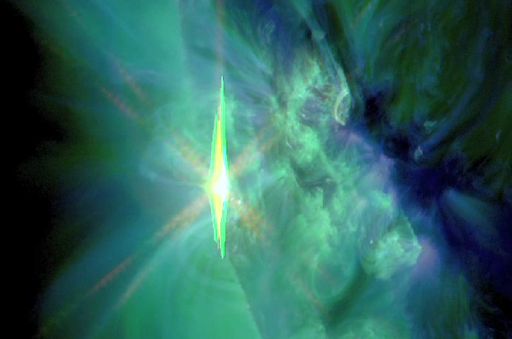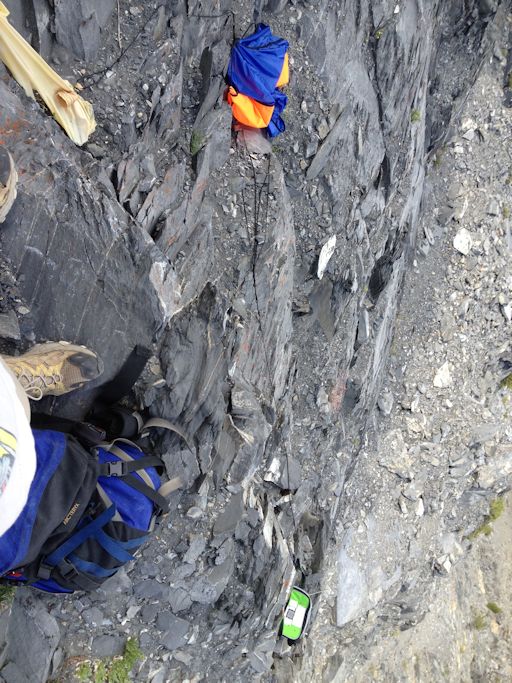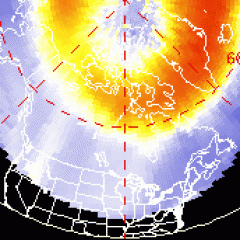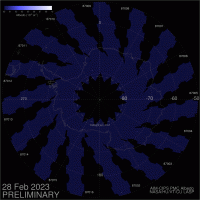M-CLASS SOLAR FLARE: Big sunspot AR1785 near the sun's southeastern limb poses a growing threat for solar flares. This morning, July 3rd at 0706 UT, it produced an M1.5-class solar flare and hurled a CME into space (not Earth-directed).
NASA's Solar Dynamics Observatory captured the flare's extreme ultraviolet flash:
The latest NOAA forecast calls for a 10% chance of M-class flares today. Based on the growth and activity of AR1785, however, the odds might be higher than that. Stay tuned for action. Solar flare alerts: text, voice.
SPACE WEATHER BALLOON CLIFFHANGER: Yesterday, July 2nd, a recovery team reached the payload of a space weather balloon launched on June 30th. It was the second attempt to retrieve the balloon from its mountainous landing site in the Sierra Nevada mountains of central California. The first attempt late on July 1st was aborted due to challenging terrain and fading sunlight. This time, the team started earlier and in the full light of midday they found the landing site. It turned out to be a real cliffhanger:
As shown above, the payload was dangling from a shear cliff face more than 1400 feet above the foot of the Nevahbe Ridge. Super-climber Michael White, a member of the Earth to Sky Calculus student group that launched the balloon, was able to reach the landing site and snag the payload from the safety of a small ledge just above the parachute. The shoe in the photo belongs to Michael.
This balloon was launched at the peak of a record-setting heat wave in the southwestern USA, bringing temperatures as high as 128 F to desert areas around the launch site. The goal of the curiosity-driven flight was to discover whether the heat wave extended all the up to the Edge of Space. To help answer the question, the balloon's payload was outfitted with two HD video cameras, a pair of GPS trackers, a GPS altimeter, a cryogenic thermometer and an ozone sensor.
Students are analyzing the footage and data now. Stay tuned for resultd!
Realtime Space Weather Photo Gallery
SOUTH POLE SKY SHOW: Summer in the north means winter in the south. The long dark winter night currently underway at the South Pole offers astronomers at that end of the Earth an unparalleled opportunity for sky watching--if they can deal with the cold. The temperature was about 85 degrees below zero F on July 1st when Robert Schwarz took this picture from the Amundsen-Scott South Pole Station:
"After a pretty lame June, aurora-wise, the Southern Lights are finally picking up again," reports Schwarz. "When I was out on July 1st to see the show, there was a super bright meteor, definitely the best I have seen in my 9 years down here. We don't get as many meteors here at the Pole because we kind of look out of the 'side window,' so this was a treat." (Note: Read this article to understand the 'side window' reference.)
More auroras are in the offing. NOAA forecasters estimate a 10% - 20% chance of polar geomagnetic storms on July 3rd and 4th. Aurora alerts: text, voice.

Solar wind
speed: 362.0 km/sec
density: 2.3 protons/cm3
explanation | more data
Updated: Today at 1416 UT
X-ray Solar Flares
6-hr max: C2 1205 UT Jul03
24-hr: M1 0708 UT Jul03
explanation | more data
Updated: Today at: 1400 UT
![]()
Daily Sun: 03 July 13
Big sunspot AR1785 poses a growing threat for flares. Credit: SDO/HMI
![]()
Sunspot number: 101
What is the sunspot number?
Updated 03 Jul 2013
Spotless Days
Current Stretch: 0 days
2013 total: 0 days (0%)
2012 total: 0 days (0%)
2011 total: 2 days (<1%)
2010 total: 51 days (14%)
2009 total: 260 days (71%)
Since 2004: 821 days
Typical Solar Min: 486 days
Update 03 Jul 2013
The Radio Sun
10.7 cm flux: 108 sfu
explanation | more data
Updated 03 Jul 2013
![]()
Current Auroral Oval:
Switch to: Europe, USA, New Zealand, Antarctica
Credit: NOAA/POES
![]()
Planetary K-index
Now: Kp= 1 quiet
24-hr max: Kp= 1 quiet
explanation | more data
Interplanetary Mag. Field
Btotal: 3.3 nT
Bz: 2.8 nT south
explanation | more data
Updated: Today at 1416 UT
![]()
Coronal Holes: 02 Jul 13
Solar wind flowing from this coronal hole could reach Earth on July 6-7. Credit: SDO/AIA.
![]()
Spaceweather.com is now posting daily satellite images of noctilucent clouds (NLCs), which hover over Earth's poles at the edge of space. The data come from NASA's AIM spacecraft. The north polar "daisy" pictured below is a composite of near-realtime images from AIM assembled by researchers at the University of Colorado's Laboratory for Atmospheric and Space Physics (LASP). |
![]() Noctilucent Clouds
Noctilucent Clouds
Switch view: Europe, USA, Asia, Polar
Updated at: 07-02-2013 12:55:02








